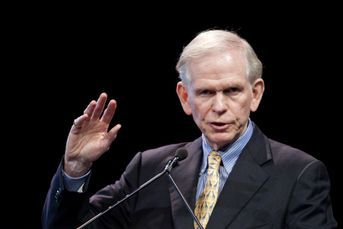Taper target: $10B each over next seven Fed meetings
Economists say initial cut sets the mold as Bernanke emphasizes flexibility.
The Federal Reserve probably will reduce its bond purchases in $10 billion increments over the next seven meetings before ending the program in December 2014, economists said.
The median forecast in a Bloomberg survey of 41 economists matches the $10 billion reduction announced on Wednesday as the Fed began to unwind quantitative easing, the unprecedented stimulus that has defined Ben S. Bernanke’s chairmanship.
The Federal Open Market Committee said in a statement that it will slow buying “in further measured steps at future meetings” if the economy improves as forecast. The Fed may taper its buying by about $10 billion per gathering, Mr. Bernanke said at a press conference in Washington.
“We’re going to take further modest steps subsequently, so that would be the general range,” Mr. Bernanke said.
Such predictable increments would extend Mr. Bernanke’s push toward greater transparency and openness at the Fed, said Dana Saporta, an economist at Credit Suisse Group AG.
“Doing this would avoid the drama of having to come to a consensus at each meeting,” Ms. Saporta said. “It may have been difficult enough to agree on the timing, size and composition of the first taper, so maybe no one has the appetite to do that on an ongoing basis.”
Mr. Bernanke’s second four-year term ends Jan. 31, and Vice Chairman Janet Yellen is awaiting Senate confirmation to succeed him.
‘MODEST STEPS’
The Fed coupled its decision to taper bond purchases with a stronger commitment to keep its benchmark interest rate low. Mr. Bernanke said the decision was intended to “keep the level of accommodation the same overall.”
Unemployment fell to a five-year low of 7% in November as employers added 203,000 workers to payrolls. Inflation measured by the personal consumption expenditures index was 0.7% in October and has remained below the Fed’s 2% objective for almost a year and a half.
The Fed’s balance sheet rose to a record $4.01 trillion as of Dec. 18, up from $2.82 trillion when it began the third round of purchases. The FOMC began QE3, as the program is known, in September 2012 with monthly purchases of $40 billion in mortgage bonds and added $45 billion in Treasury purchases starting in December 2012.
The balance sheet will expand to about $4.4 trillion by the time the program ends, according to median estimates in the survey. Economists forecast purchases in the third round eventually will reach $800 billion in mortgage bonds and $789 billion in Treasuries.
(Bloomberg News)
Learn more about reprints and licensing for this article.








